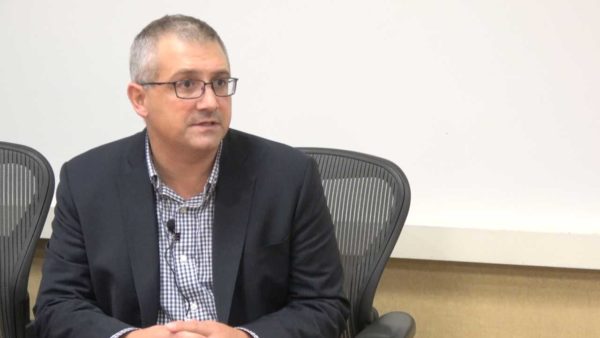A Q&A with Susan (Nicki) Hastings, MD, MHS, & Steven Z. George, PT, PhD, FAPTA
AIM Back Trial
Improving veteran access to nonpharmacological approaches
Susan (Nicki) Hastings, MD, MHS, is a geriatrician and Professor of Medicine and Population Health Sciences at Duke University School of Medicine. Dr. Hastings is also director of ADAPT, a VA Health Services Research Center of Innovation at the Durham VA Health Care System. Her research focuses on improving function and independence for older adults, including developing programs to improve mobility during hospitalization for older adults.
Steven Z. George, PT, PhD is in the Laszlo Ormandy Distinguished Professor in Orthopaedic Surgery and Therapeutic Area Lead for Musculoskeletal and Surgical Sciences for the Duke Clinical Research Institute. Dr. George’s primary research interest centers around the prevention and nonpharmacologic treatment of chronic musculoskeletal pain disorders, with a biopsychosocial approach. Dr. George is an active member of the American Physical Therapy Association, United States Association for the Study of Pain, and International Association for the Study of Pain.
Nicki Hastings (NH): Steven George, PhD, and I joined forces to design the AIM Back trial, which is an embedded pragmatic clinical trial that’s being conducted at 16 clinics within the VA Health Care System. We are testing two pathways for delivering nonpharmacologic low back pain care and comparing them to see what their effects are in terms of reducing pain and improving function. I’m really excited about the trial for a couple of reasons. First, the embedded nature of the trial means that we are testing the impact of delivering these pathways using existing clinical resources and I think this is going to give us a lot of information about which one of these pathways would be most effective in the ‘real-world’ so to speak. Second, we were able to have a unique development process for this trial. We had a deliberate process to get input from multiple stakeholders on designing these pathways to optimally achieve their goals of increasing nonpharmacologic care access. Stakeholders included providers within and outside of the VA Health Care System, and importantly, veterans. This process increases the likelihood that whichever of these pathways shows to be superior can be implemented in the VA system and perhaps beyond.
NH: In addition to chiropractic care and physical therapy, things like mindfulness, meditation, Tai Chi, and yoga, are all options that can be very appropriate for pain management and yield improved results. We need to flip the script and help all patients understand that these are really the first choice options and that these kinds of self-activating therapies are a critical part of managing pain.
NH: The therapies that are being directly delivered within the context of the VA Health System have some advantages since patients have access to many wonderful programs that are available within the VA community. It is easier for veterans and their family members when programs are directly delivered within the VA Health System, and I think those tend to be the ones that patients have the highest potential to engage with over the long term. The challenge is that not all programs are available within each individual VA. Another part of our PMC study is evaluating patient preferences and interests for certain kinds of therapies, and combining that with a tailored list of what local resources are available. That way, we can match appropriate therapies to each individual and get veterans engaged in the programs that they’re most interested in.
NH: The VA has led the way in pain management, and has particularly embraced the biopsychosocial model of pain care–that the pain experience is individualized and more than just a biomechanical issue that can be addressed with procedures, surgery, and/or medication. That culture change within the VA has helped, as has the VA stepped care model where primary care providers are encouraged to start with the lower-intensity, evidence-informed therapies. Also, the Whole Health approach to care emphasizes self-action and direct provision of complementary and integrative services. This kind of philosophy and patient-centered focus is not consistently available outside of the VA. The VA Health Care System’s leadership role in this arena sets the stage nicely for a study like ours, where we are looking to find the optimal way to organize non-drug pain care approaches and deliver them effectively and earlier on in the process. It allows us to individualize pain care, starting with lower intensity options and avoiding things that might be risky, and taking into account the fact that some patients are at higher risk of going on to develop a disability around their pain.
SG: Obviously, we are going through a period where people are exploring remote delivery mechanisms for pain management. Since people have been looking at and providing virtual healthcare delivery, there already is a fair amount of research and data for general care. In my read of the literature, the outcomes seem comparable for most patient populations, or at least no indication that it is definitely worse. The virtual care models have an advantage in that it’s just easier to access treatments. I think as people start to build virtual components into their study designs, we will know more about applying telehealth to populations that need to have increased access, especially to pain management.
SG: We were still recruiting sites when COVID-19 limited in-patient visits to health care facilities. That pause allowed us to have a faster cadence in talking to sites because we were able to take advantage of slower clinical schedules at some of our sites. So, we actually benefitted from not actively recruiting when everything was disrupted in March.
After COVID, it was pretty clear that travel restrictions would require us to do the implementation phase through the power of Zoom and other virtual platforms, which our clinical pathways had already incorporated elements of, so they were already semi-COVID-friendly. In talking with our trial sites, it became clear that they would be able to implement a hybrid approach where they have some short onsite visits and then transition patients to a structured virtual delivery component. Afterward, patients may be able to come back to site for reevaluation. One of the biggest changes is that we needed to create virtual site trainings, instead of doing some activities in person. In the end, the impact of COVID-19 ended up being relatively minor for our trial, compared to others in the PMC—although this is not meant to imply the impact of COVID-19 is minor—and we were still able to move forward with the pathways we originally proposed.
Working Documents & Other Information
Pathways for Managing Low Back Pain
Four PMC PIs note a need for better pathways for...
Read MoreSteven George, PT, PhD on Improving Patient Access to Integrated Pain Management of Chronic Back Pain
(Video) Steven George, PT, PhD, touches on study with the...
Read MoreImproving Veteran Access to Integrated Management of Low Back Pain (AIM Back trial)
There are critical unanswered questions surrounding best practices for addressing...
Read More


